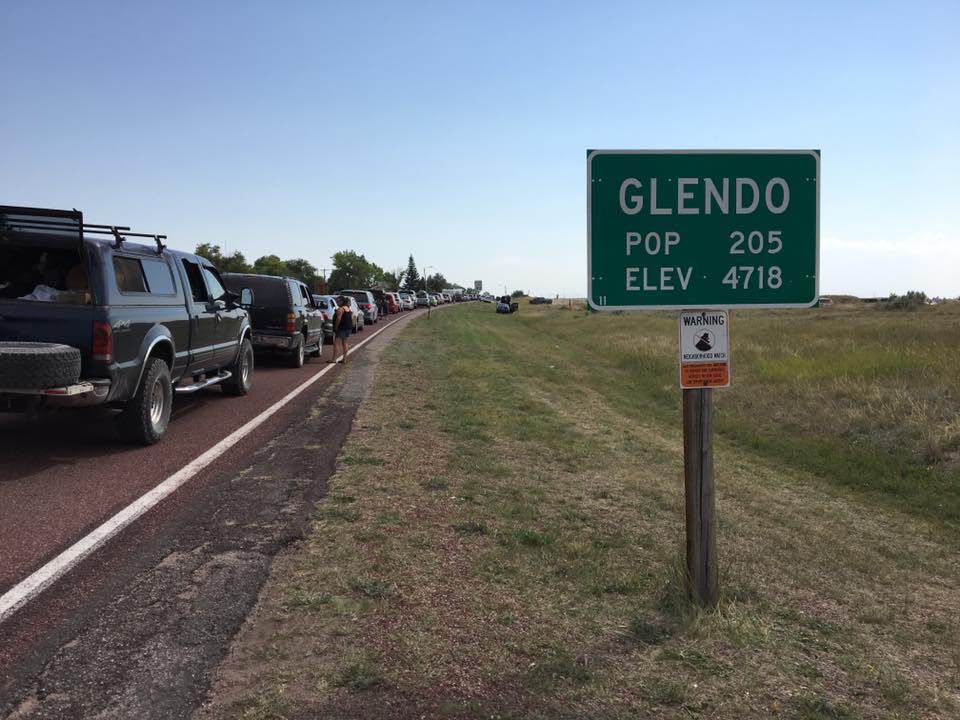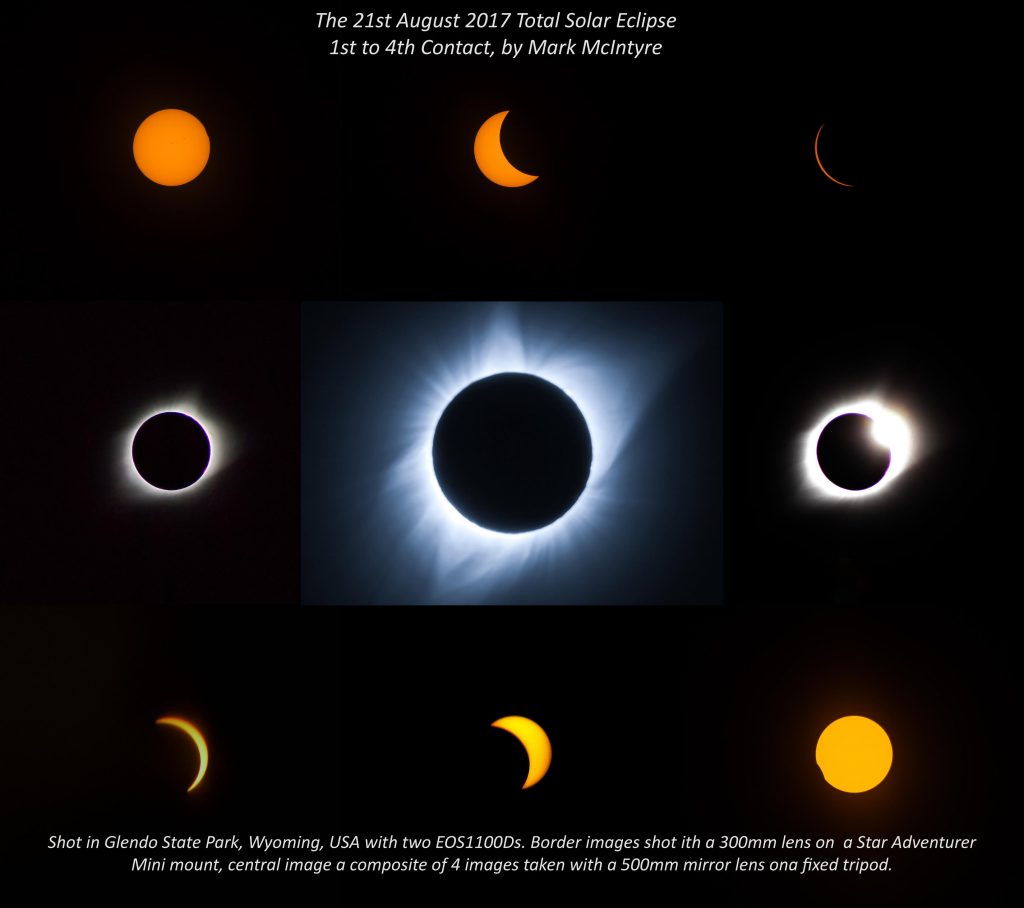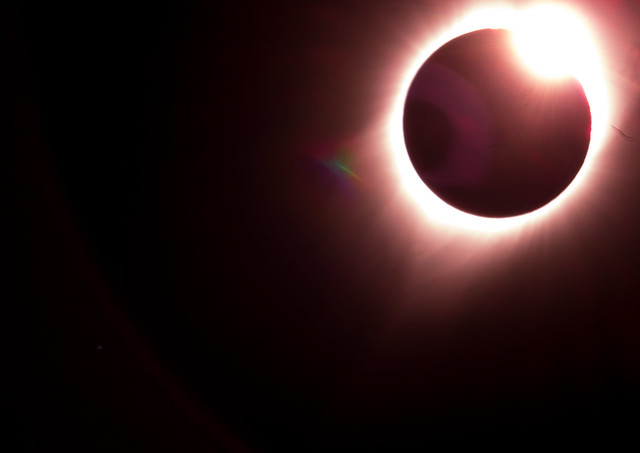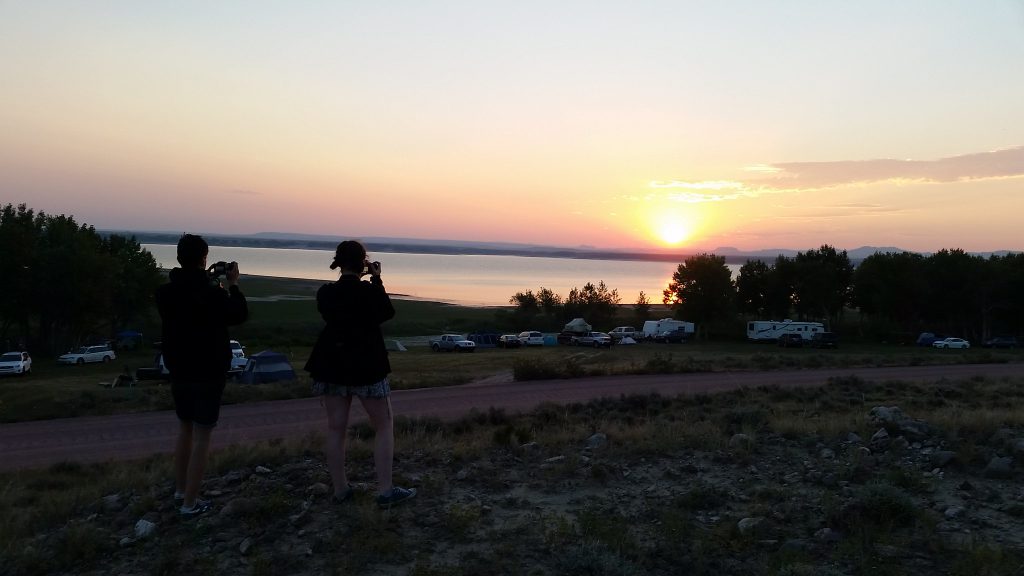
Our Journey to see the Great American Solar Eclipse of 2017
This is an account of our trip to Wyoming to see the 2017 total solar eclipse. It is also an account of our honeymoon!
When Mary and I decided to get married we wanted to do something a bit more exciting then the usual week in the Sun for our honeymoon– being astronomers and science geeks, we naturally wanted to see a Solar Eclipse! As it happened there was a Solar Eclipse ‘just round the corner’ in August 2017. Very convenient… So we began to plan.
Of course, there were one or two complications! Firstly it needed to be a family holiday as Mark’s youngest two children would be coming with us. So we couldn’t just fly to the US and back, as one of our friends did for the Australian eclipse a few years earlier. We needed somewhere there was other stuff to do.
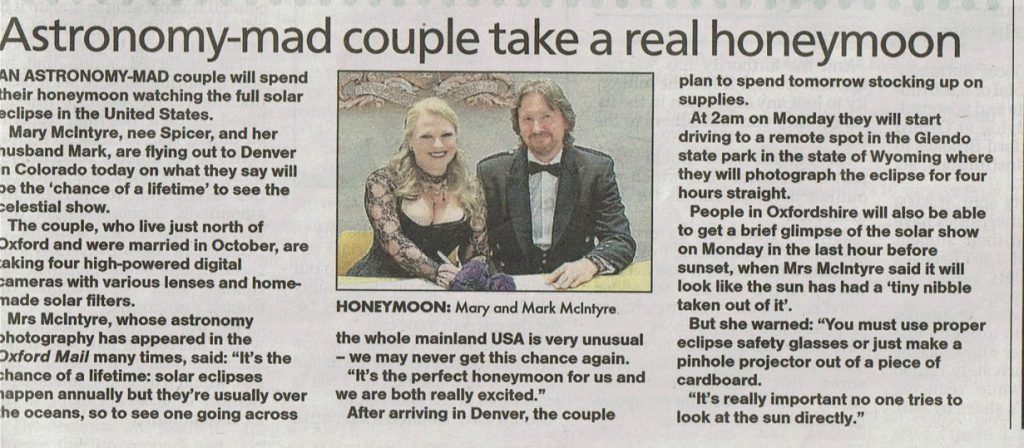
Secondly, the eclipse was of course big news, and soon our local paper and radio station got wind of our plans. Mary has been interviewed for the Oxford Mail and been on Radio Oxford before and they turn to her for any astronomy related matters so inevitably they wanted the story.
In fact the radio wanted a live interview from location! Sadly we had to inform them that there’s no internet in the middle of the Prairie, so a live broadcast from the event was out of the question. Still, the paper wanted a Before and After story… and admittedly it did make good headlines !
The Great American Eclipse of 2017
On the 21st August 2017, a total eclipse of the Sun was visible from a 100km wide strip of land covering the entire continental USA from south of Portland in Oregon to Charleston in South Carolina.
But what actually IS a Solar Eclipse ?
A Solar Eclipse happens when the Moon passes between the Earth and Sun and its shadow falls on the Earth’s surface. Because the Moon and Sun look roughly the same size in the sky, the Moon is able to briefly ‘blot out’ the Sun, leading to a brief period of darkness for anyone in the area covered by the shadow.
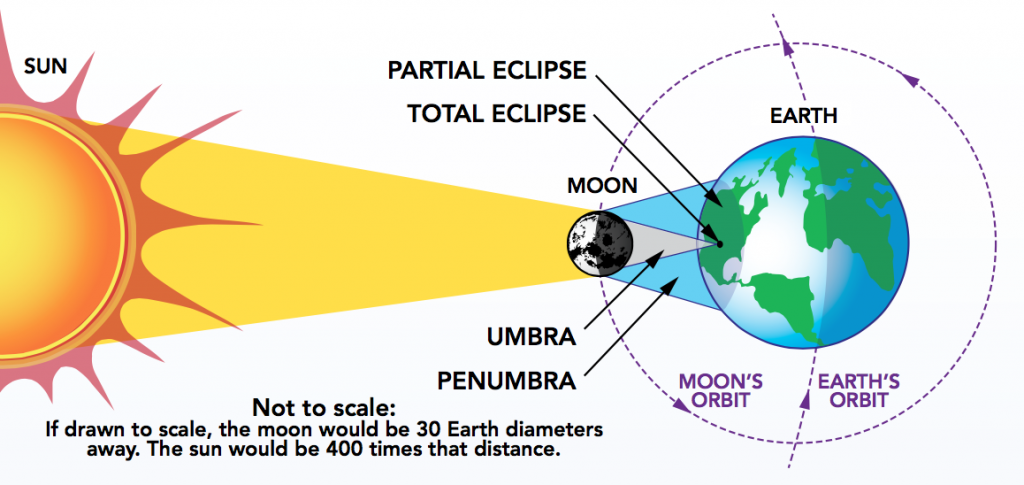
As the Earth rotates, the shadow moves across the landscape from west to east at over a thousand miles an hour, so the eclipse lasts only a few minutes in any one place. The duration of the eclipse depends on the size of the shadow. If the Moon is nearer to the Earth then its shadow is bigger causing a longer eclipse; further away and the eclipse is shorter due to the smaller shadow. It’s even possible for the moon to be a little bit too far away so that it doesn’t completely cover the sun, leaving a thin ring of sunlight visible, known as an Annular Eclipse. Total Eclipses can last anything from a few seconds to seven or eight minutes. This one lasted about two and a half minutes.
Are Eclipses Rare?
Contrary to popular belief, total Solar Eclipses are commonplace – in fact there’s roughly one every 12 to 18 months. Really? Yes! The table below shows the elipses from 2018 to 2020. In fact because the Moon orbits the Earth once a month, it follows that an eclipse is actually possible every time there’s a new Moon.

So the real question is why don’t they happen more often! Well, the Moon’s orbit is tilted a bit, so most of the time the shadow misses the Earth completely. Space is big, really big, as Douglas Adams explained, and the Moon is 400,000km away from the Earth. If the Earth was the size of a beach ball, lets say 45cm, then the moon would be 15 metres away and the size of a grapefruit. You can see that you’d need to be pretty well aligned to get the grapefruit’s shadow to land on the beach ball. When the moon doesn’t pass exactly between the Earth an Sun but still covers part of it, we have a Partial Eclipse.
What made this one special?
If eclipses happen every 12-18 months, why was this one so special? Well, because of where it happened. Oceans and ice cover 70% of surface of the Earth and so most eclipses don’t pass over much land as you can see from the graphic below[1]. Even when they do pass over land, all too often they are in hard-to-get-to places like Antarctica, the jungles of Peru, Siberia, Greenland or the Sahara Desert, as the picture below also shows.

And that’s what made the 2017 Eclipse special and makes the 2024 one special too. Their tracks take them across a populated country with good road and transport networks, that’s safe to visit, easy to fly to and has plenty of places to stay. Eclipses like that are rare and special !

So that’s why we went to the USA in 2017. And its why we hope to go back in 2024 – and to Spain in 2026 and 2027 if we can manage it ! I’m afraid you’ll need to wait till 2090 to see one in the UK though.
2015 – Start Planning for the Eclipse Trip
The rarity of this eclipse made it essential to plan ahead. Most of the population of the USA lived within an day’s drive of the track, not to mention the tens of thousands who like us would be flying in from all over the world, and so hotels, car hire and flights were going to get booked up. Therefore in 2015, not long after the eclipse that year crossed the North Atlantic and Svalbard, we started planning.
Where to Stay and How to get to the Path of the Eclipse
By July 2015 we had printed maps of every state the Eclipse passed through and had made a giant map of the whole path on our dining room wall. We also had a map of the UK to scale to give us an idea of how far apart things were. This was the first time it really hit home how HUGE the USA is and how far we’d have to drive. We also bought books and maps showing the path, weather, traffic predictions and more.
To add to the fun, we planned to take my teenage children so it was essential that we made it more than just an Eclipse trip. Flying 5000 miles to spend a day in a field without wifi or phone signal wasn’t going to wash with two teenagers!
We also knew that traffic on the day was likely to be horrendous, so we wanted to avoid too much driving on the actual day of the Eclipse. In theory anyway….


We considered many options.
Initially thought about flying to Florida to visit Kennedy Space Centre, then either flying north or hiring a Winnebago and driving up to cross the track perhaps in Tennessee or the Carolinas. But when we looked at the wall map we realised that would mean driving thousands of miles. And if we flew, the cost of multiple flights would be enormous.
So we then looked at flying to the West Coast and driving north to Oregon or Idaho. In fact some of our friends did this, spending two weeks on the road visiting Death Valley, Las Vega, Yellowstone, and many other places. They had an awesome time!
But in the end we plumped for a simpler plan which I’ll come to in a bit.
Weather Worries
We also started researching the weather along the track. To see the eclipse at its best you obviously want a cloud free sky! Fred Espenak, an eclipse specialist who works for NASA, produced some really useful maps and there were many websites and other resources.
Of course, no two maps agreed – when did weathermen ever agree about the forecast for tomorrow, let alone two years hence – but they all agreed that the places least likely to suffer clouds would be somewhere in the Mid West or West, between Nebraska and Oregon. While Oregon had some attractions – its easier to fly to Portland and there are lots of big towns – its also a very populated area and we were concerned that traffic and hotels would be very difficult.

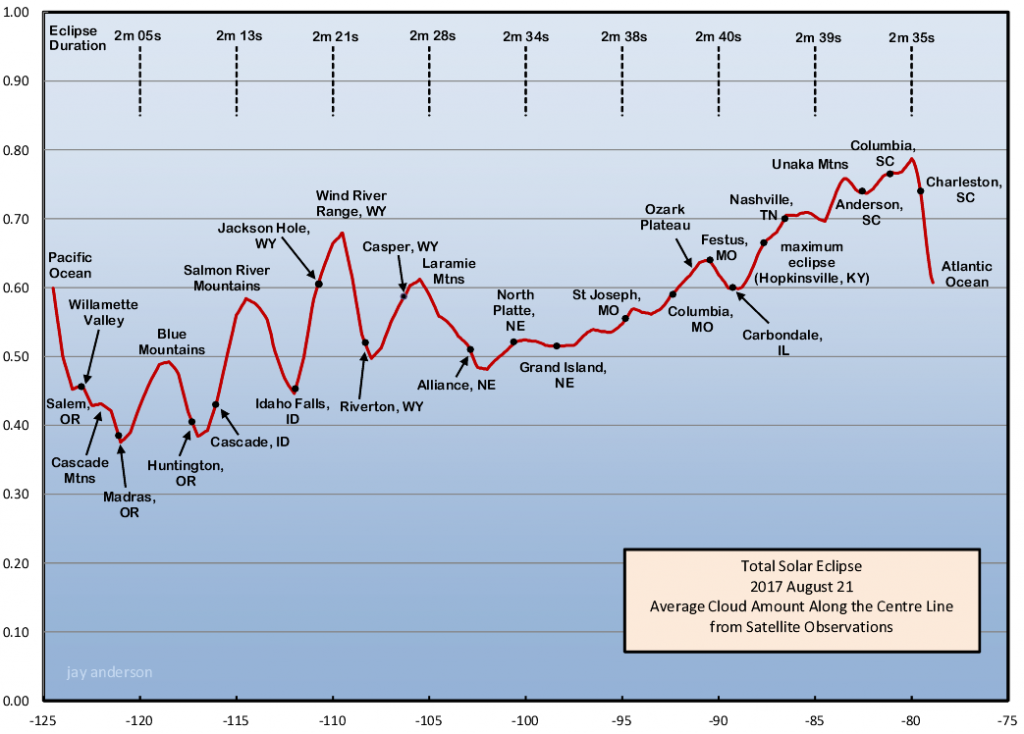
So we decided to aim for the Mid West. Now the only question was where exactly?
Summer 2016 – Detailed Planning Starts
By the summer of 2016, we’d narrowed our target down to somewhere between Alliance and Grand Island, Nebraska. Why there?
Mobility on the day is very important – it might be cloudy at your chosen site, but if you could drive along the track a little you might find clear skies. And the Interstate from Alliance to Grand Island runs more or less due east, entirely within the eclipse track.
So this region looked like a good spot. If the weather were poor in one place perhaps we could dash west or east.

Now the question was, how to get there and where to stay?
Finding A Hotel
Putting these two problems together, it dawned on us that we were going to have to stay outside the track and drive in. Earlier on we’d discounted the idea of driving too far but 200 miles was only a few hours, and the map showed us three possible routes from Denver to the right area. Again a choice of targets was good news as it would let us adapt to bad weather or traffic.
Ideally, for an eclipse you want to spend the night before actually in the target zone – there would be nothing worse than getting stuck in a traffic jam and missing it ! However finding a hotel was going to be interesting because although it was still more than a year away, we were already hearing from friends that hotels were booked up and that prices were rising rapidly. The problem is that Nebraska is really sparsely populated and there aren’t many big towns with hotels.
The other problem with Nebraska was where to fly to? There are no direct flights from the UK to Nebraska and in fact the nearest place with direct flights from the UK is Denver, which is 200 miles south of the track.
Putting these two problems together, it dawned on us that we were going to have to stay outside the track and drive in. Earlier on we’d discounted the idea of driving too far but 200 miles was only a few hours, and the map showed us three possible routes from Denver to the right area. Again a choice of targets was good news as it would let us adapt to bad weather or traffic.
And so in July 2016, Denver was chosen as our Base Camp.

Late 2016 – Plans Solidify
In the summer of 2016 we had a lovely family holiday in Barcelona and for a few weeks we could forget about eclipses and just relax with sun, sangria and sand.
As soon as we got back we started looking for places to stay in or near Denver. It didn’t need to be posh as we expected to be out and about a lot of the time, but we needed accommodation for four, for a week, with parking and breakfast. We soon found somewhere that seemed ok, and booked a suite at a hotel near Denver Airport. We were going to have to share a room but we all agreed that would be fine. Denver was also great as there’s lots to do in the area – a zoo, science museum, the Rockies, and so on. We also decided to visit Breckenridge. This was very special for Mary as she used to ski there before she injured her back, and had never thought she’d be able to go back. We were going to be there in summer but it would still be very meaningful for Mary, and I really wanted to see the place she’d talked so much about.
As soon as we had the hotel organized we booked flights, easily the most expensive part of the whole trip, though as a bonus it came with car hire included. BA fly to Denver daily and though they’re not the cheapest they are generally pretty reliable. The car hire was with Avis which also seemed a good choice.
So now we had a base, we knew how we were getting there, and we had a car to drive to our viewing site. It was all coming together.
Mark’s Reflection on Planning
Some years ago we met Chris Hadfield, former commander of the International Space Station and awesome guy. One thing he said really struck me. “When at NASA” he said, “we were taught to ‘sweat the small things’”. Now that’s the opposite of what most people say, they say don’t worry about the little things.
But what Chris meant was simple. Don’t try to solve a huge problem in one go, break it into small manageable chunks and deal with each little thing in priority order. The example he gave was when the ISS was hit by a meteor. They lost power, were leaking atmosphere, the heating was dead, the computers were down, and so on. Everything was going wrong and they had no help from Earth. So they focused on one thing at a time, the thing that got them one step nearer being safe. An air leak is going to kill you faster than the cold so plug that first. Then once you’ve plugged the leak, fix the electrics because maybe that will fix the heating. And if it doesn’t at least the computers are back and you can see the system diagnostics. And so on, till they were safe. One little thing at a time.
And that’s the approach I took to Eclipse Planning. Break it into smaller decisions, each step moving us closer to our goal. Choosing the region of the USA gave us a general target, the flights moved us to the right continent, the hotel gave us a roof over our heads, the car would get us to the right state. We were nearly there!
Early 2017 – Changing Our Minds….
Except….. in early 2017, we looked again at the maps. While the Alliance-Grand Junction area looked good, the weather would be better further west, and actually it was more like 6-7 hours drive from Denver. We also had no idea how hard it would be to find somewhere to park, set up our cameras, and safely watch. Parking at the side of the interstate would be illegal or dangerous, and it seemed likely that private land would be off limits, costly or booked.
What if we drove north instead, into Wyoming? Interstate-25 went due north and it was only 200 miles to the track near Wheatland after which I-25 curved west, still inside the track, to Casper, Riverton and even Jasper which gave us options in case of bad weather.
A little more research picked out the town of Glendo which was almost exactly on the centre line where the eclipse would be longest, and it had a State Park right next door which was selling parking permits for the day for $45. The scenery looked spectacular, and though not as amazing as round say Jackson Hole or the Grand Tetons, the weather would be as good and getting there would be easier. So in March 2017 we had a change of target and bought a day-pass to Glendo State Park.
One small step closer. Now we had flights, hotel, a car and a new place we could park up. It was all getting very real !
June 2017 – Last Minute Panic!!
Nothing ever goes smoothly of course.
Mark had been vaguely worried about the hotel, he’s still not sure why – and so in June with two months to go he double checked the Tripadvisor reviews and discovered the hotel was being rebuilt ! It was a huge building site with no parking or food onsite, terrible reviews and dire warnings. So a last minute replan had to be done on the hotel too. Fortunately we were able to find a suitable alternative at the Holiday Inn near Denver Airport, just as convenient and actually slightly cheaper.
Now we had confirmed flights, a new hotel, car and somewher to park up. All we needed to do was get there…. Oh, and to take the right equipment.
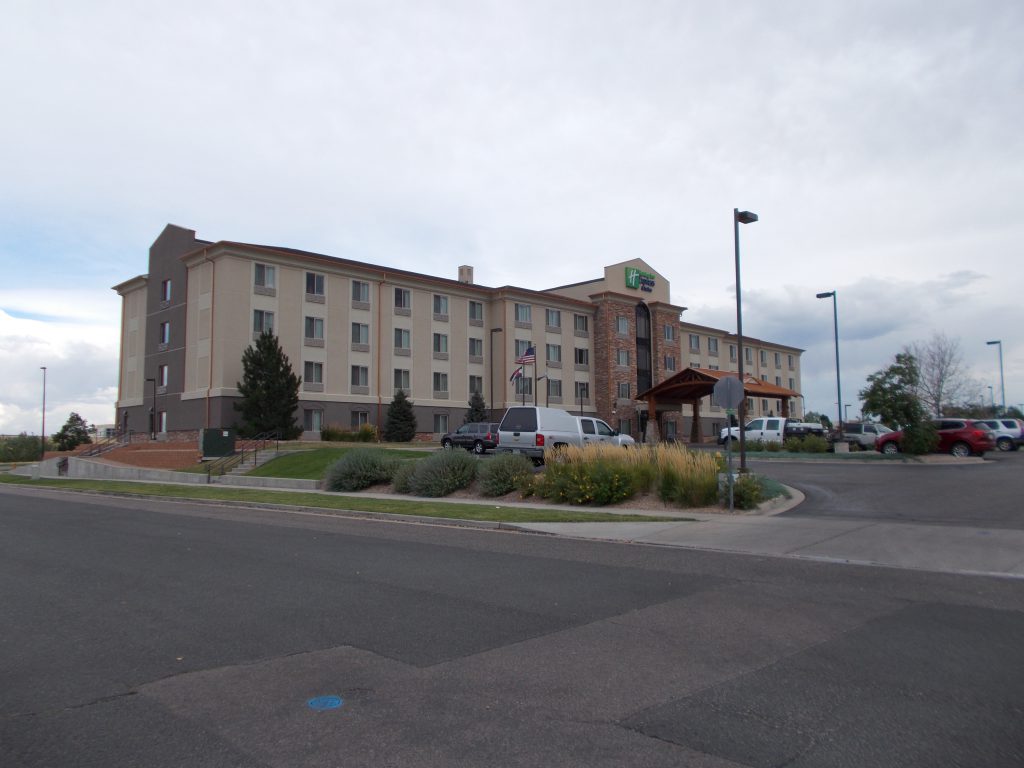
June 2017 – Equipment
We always knew we wanted to photograph the Eclipse, of course and like finding somewhere to stay, this required advanced planning. We needed solar filters for our cameras and solar glasses for ourselves, and we needed the right cameras.
We ended up taking
- One DSLR with a 300mm lens on a tracking mount (Star Adventurer Mini), to take continuous close-ups showing the Moon moving over the Sun.
- One DSLR on a fixed tripod with a wide angle lens, to take a wide field view showing the Sun moving across the sky.
- Two handmade solar filters for the above cameras.
- A bag of solar eclipse glasses, for us and anyone else who needed some.
- One DSLR with a 500mm mirror lens and one with a 300mm lens, both hand-tracked.
- Two bridge cameras (my teenagers’) for handheld shots.
- Four phone cameras for landscape and scenic shots.
- A compact camera (which didn’t get used on the day).
- A white sheet to look for shadow bands (we didn’t see any)
In retrospect i wish i’d set up a camera on a tripod looking at us as we setup and observed. We could have made a great timelapse with it.
We also took a cooler full of drinks (it was due to be at least 33C in the shade), breakfast, snacks, a first aid kit, blankets to lie on, cushions to sit and sleep on, light clothes for the heat of the day, warm clothes for early morning. We forgot bug spray but fortunately didn’t need it.
We were very glad of the food and drink on the way home as you will see later.
19th August – We Finally Set off.
Early in the morning of 19th August we set off for Heathrow, suitcases packed mostly with Cameras and tripods. We arrived at Heathrow in good time and had our first shock when our 17 year old Catriona was taken aside for “Extra Security Checks”. To this day we have no idea why. It was all fine of course but really not what we wanted!
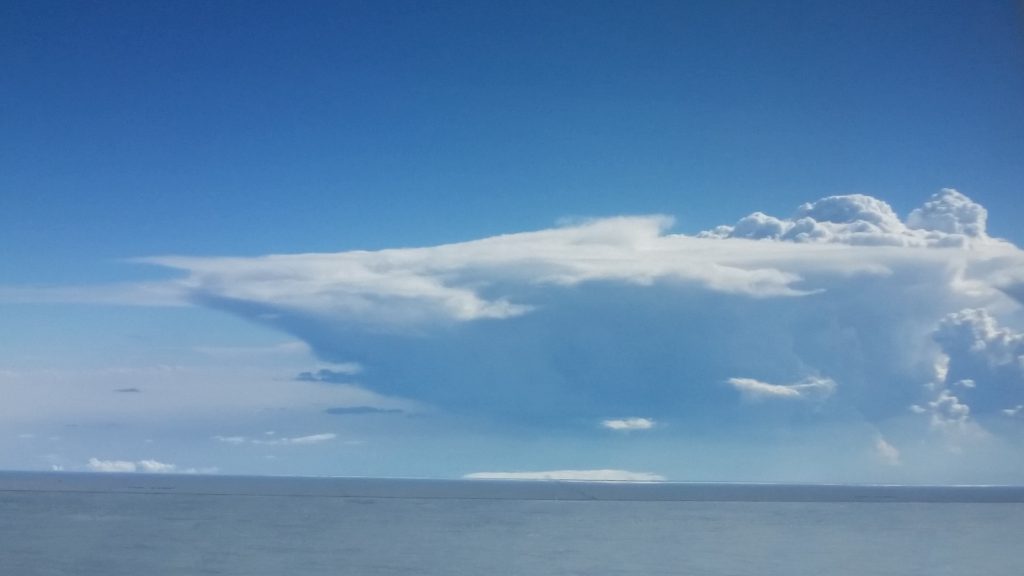
The flight was spectacular. While flying over the northern USA we saw some amazing thunderheads, thousands of feet high and enormous. While they were amazing, at the same time we hoped very much they weren’t heading west towards Glendo. Thunderstorms on the 21st definitely NOT REQUIRED!
We landed on time but Cat was once again singled out for special treatment by the TSA again without explanation or issues. This time we had actually gone through customs and were picking our baggage when the TSA came out and escorted her away. This delayed us a bit and by the time we got to the Car Hire place it was late, we were all tired, hungry and at the back of the queue. But eventually we got to our hotel and we all fell into bed after more than 24 hours travelling.
21st August – The Day Finally Dawns
We spent Sunday recovering from our flight and shopping for perishable essentials for the day.
Then we made our final plans.
Back to the ‘small things’: there were 200 miles to Glendo, we had a full tank of gas, it was dark and we had our sunglasses. We had to get into the path of the eclipse which meant getting at least as far north as Wheatland, 160 miles north of Denver, by 11.46 MDT. And that was starting to look like a problem.
All day Saturday we were hearing rumours of traffic problems. The TV news was full of dire warnings, the internet was awash with forecasts of 100,000 cars on the road north, trucks were being banned from the state and things were getting tense. We went to bed early but set alarms for every thirty minutes so we could check the traffic news. We couldn’t get into the Park till 6am but we were worried that we’d get stuck en route or get there to find the park was full already.
Of course, sleep was out of the question so in the end, we got up at 1.30am, packed the car and set off in the dark. Our hearts were in our mouths – would it work out?
The moment of truth had arrived !

The Drive North
Mark did most of the driving, and this part is in his words.
“We set off in the early hours, hoping to beat the rush. We’d filled up with gas the night before, the food and supplies were ready, we filled the cooler with ice from the hotel ice machine, we programmed our route into the satnav, and all we had to do was beat the traffic. Time to see if two years of planning would work out.
At first traffic was quite heavy, but by the time we passed Fort Collins it seemed no worse than a normal UK motorway. We passed the half-way mark Cheyenne at about 3am without incident. The traffic was definitely building up now however and by the time we passed Chugwater it was getting heavy. My heart was beating faster and faster, but now I knew we had only ten miles to go till we were inside the track.
The sign for Wheatland came up at the roadside. I could hardly breathe I was so excited because now we were on the very edge of the track of totality. And then we were past the tractor showroom and grain silos, and out the other side.
We had done it! We were inside the track. Whatever happened now, we were definitely going to see a total eclipse. The car could break down, we could hit solid traffic, it didn’t matter – we were going to see the most amazing sight on earth! I actually yelled in excitement. Another of my “little things” ticked off.
We weren’t quite there yet – another 30 miles to go, and we’d be at our target but now the traffic was definitely heavier, and by the time we saw the sign for Glendo the inside lane was really slowing down. We saw why a moment later, already at 4.30am cars were queued up on the freeway all the way to the Park entrance two miles off
We passed the gas station – where in hindsight we should have filled up – and made it to the Park about 5am. Our pass let us in even though we were early, and quickly we parked up in the designated area. We rested briefly but dawn was already breaking and to be honest we were far too excited.

Glendo State Park
Glendo State park is an amazing place. It is a place of rolling prairie land, wildlife, clumps of cottonwood and pine around a huge reservoir, stony buttes with spectacular views – and thousands of crickets. Our blankets were covered! It felt straight out of the Laura Ingalls Wilder books. As dawn broke the kids and Mark went exploring while Mary rested. Amazingly on our wanders we met someone who had been a student at Oxford, as well as seeing our first Horned Toad and American Antelope.
From the top of the butte we could also see the park – and realisation dawned of how many people were arriving. We later on found out that the park had 45,000 visitors, and Glendo in total had over 100,000. The population of the town is 203 normally.
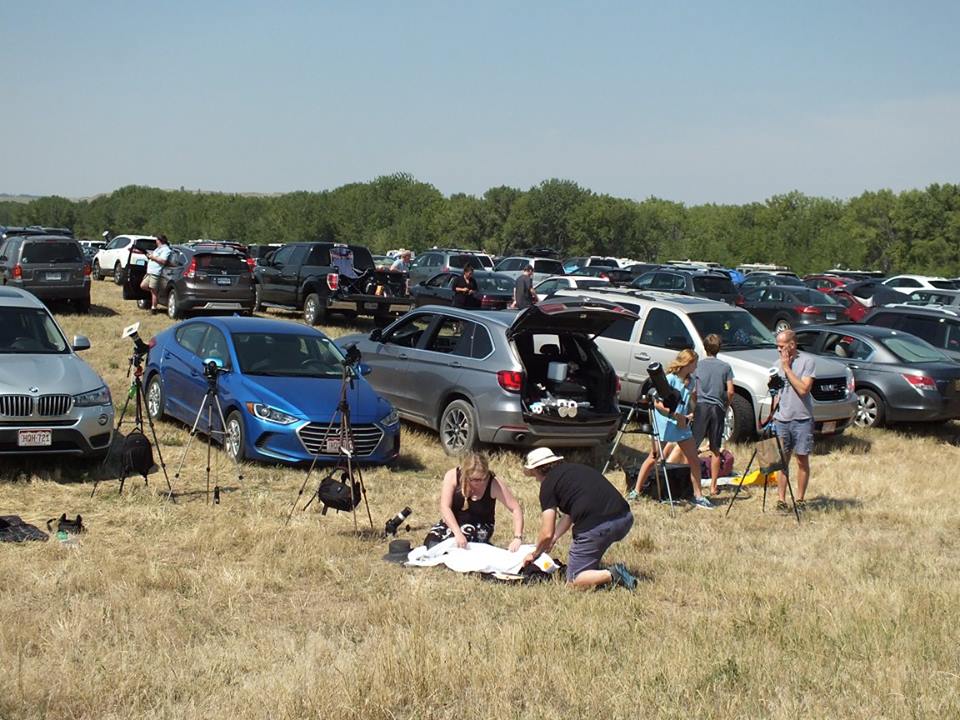
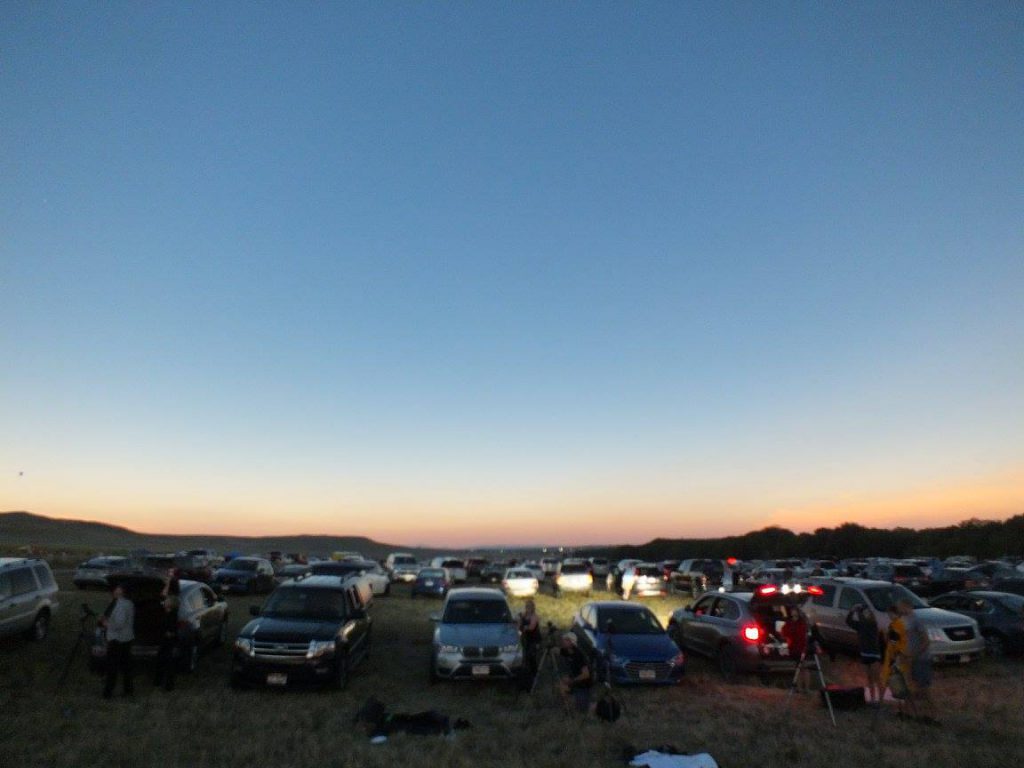
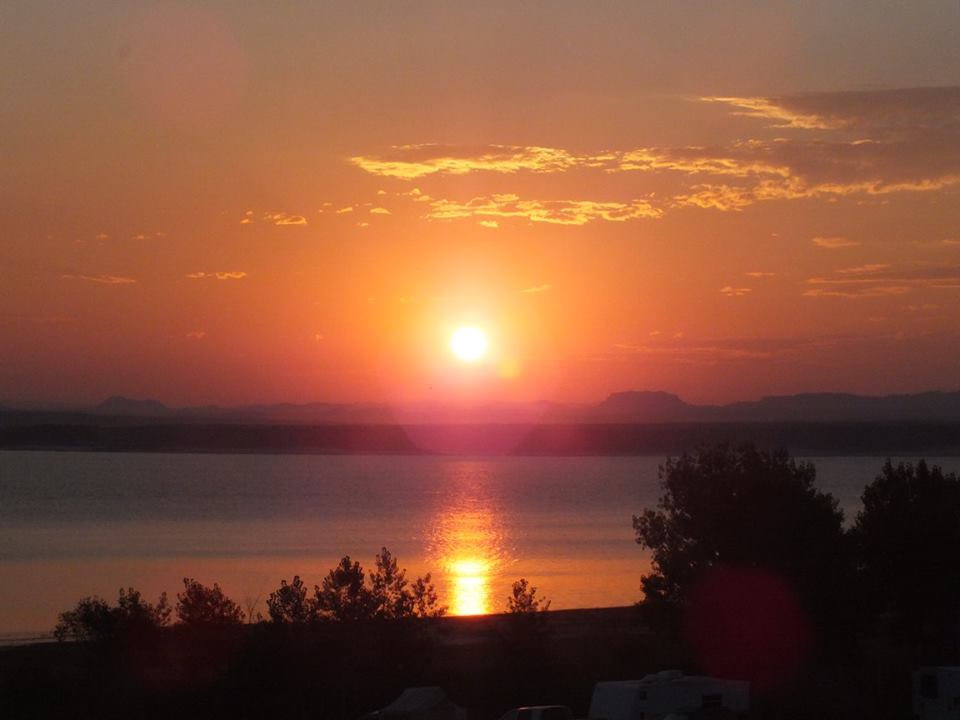

Everything Ready
By 09.30 we had set up our cameras. The Moon was due to start nudging in front of the Sun by 10.24MDT and we wanted to capture the whole thing if possible.
One camera was set up in a fixed position pointing at where totality would happen, and would be left running all day taking pictures at 1-2 minute intervals from the start to the end of the Partial phases (known as C1 and C4). This camera had a filter on and the plan was to remove it during totality.
Another camera with filter was set on a tracking mount, following the sun on its path across the sky, and would capture the slow progress of the moon over it, through totality and then away. The other two DSLRs were on tripods and would be manually pointed during totality.
The children had their bridge cameras and we all had phone cameras, and during the day we all intended to take pictures of the landscape, the sun through solar glasses, the shadows, the changing light and so on. Although the main interest is in the watching the Sun vanish, many other interesting things happen during an eclipse. It gets cold and dark, fooling animals into thinking it is dusk. Mysterious ‘shadow bands’ rush across the ground – the shadows of ripples in the air, showing up only when a thin crescent sun shines. And at totality there’s a 360 degree ‘sunset’.
Then at 10.24, the Moon began to obscure the Sun. Slowly over the next 70 minutes, little by little, the Moon crept further across the disk of the Sun.
At first we noticed little difference but by 11.40 it was beginning to get darker – and colder! It had been 33C at 10am, but already it was appreciably cooler. Other odd things began to happen too – as the sun’s crescent shrank, our shadows got sharper and sharper. We didn’t see any shadow bands but these only happen in the minutes before totality – and to be honest we were quite busy then !
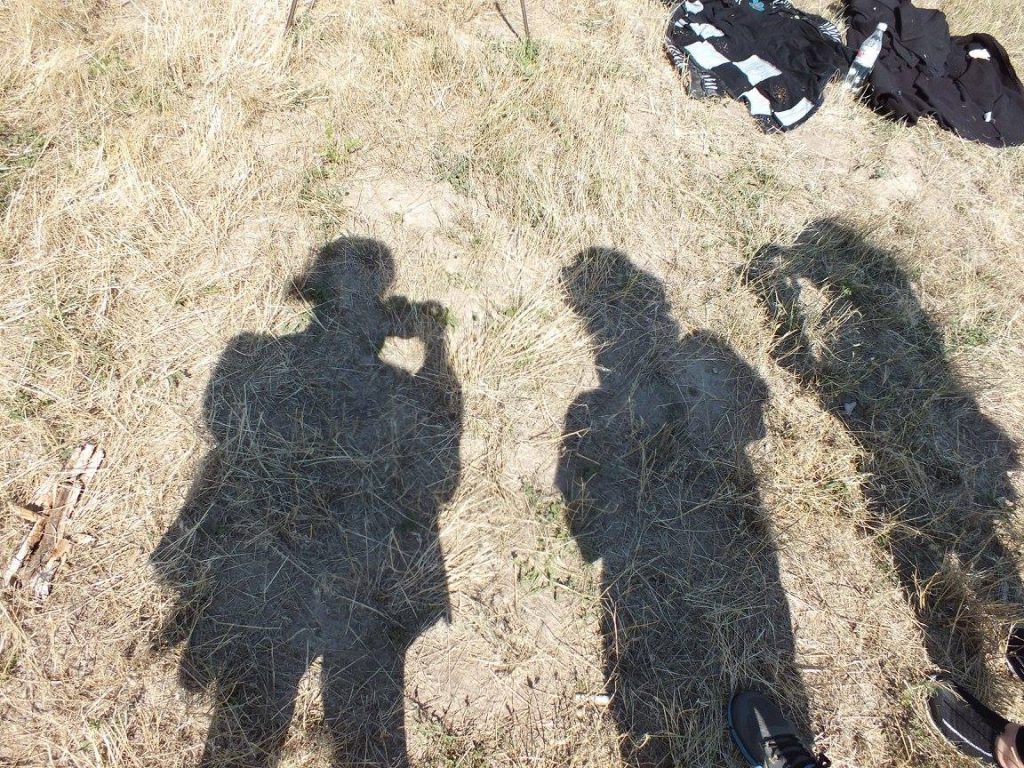
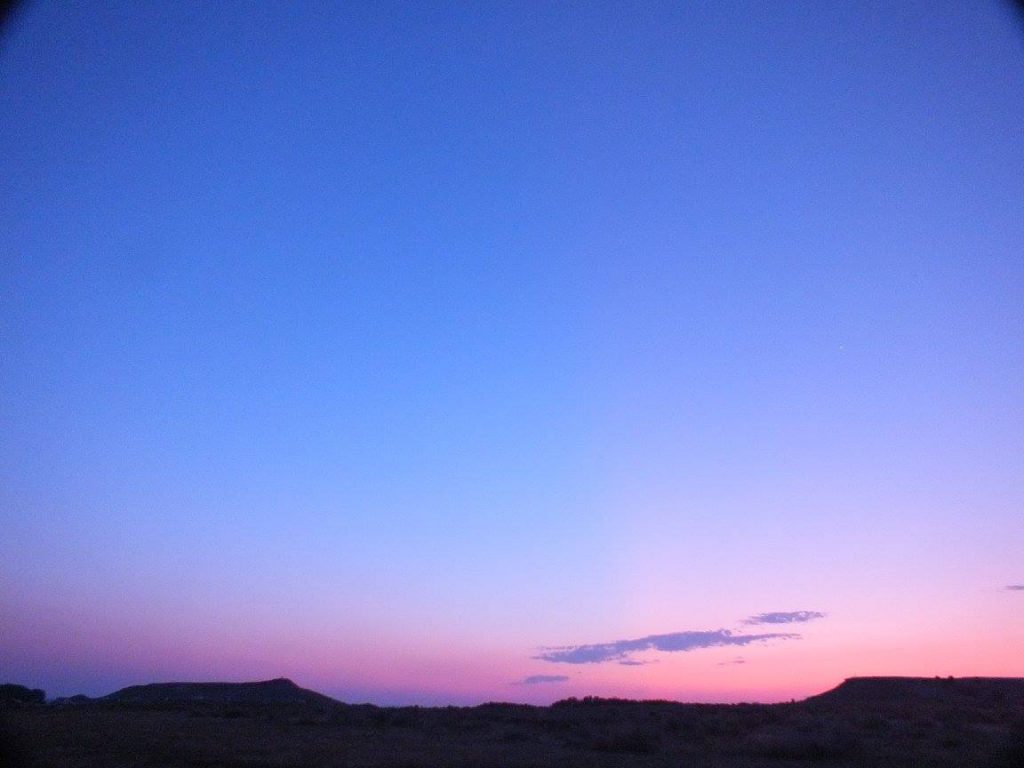
At 11.43, the light began to fade rapidly. A hush fell across the 45,000 people around us. The insects stopped singing. On our cameras, the sun was almost gone, with just a tiny sliver still visible. We pulled our camera filters off just in time.
AND THEN IT HAPPENED !
Totality !!!
The last sliver of Sun vanished and in an instant was replaced by a diamond ring around a black hole in the sky. A huge cheer went up from around us. Dimly on the cameras we could see the moon’s familiar patterns, but surrounded now by the incredible sight of the Sun’s corona. With trembling hands we adjusted exposure and shot some images, then took time to just look.
It is truly an incredible experience. Nothing, no description, no pictures, no video, can prepare you for the real thing. Mary was actually weeping and Mark wasn’t much better. We looked around at the “sunset” surrounding us on every site, the strange colours in the sky. We marvelled at the naked-eye sight of the sun’s atmosphere streaming millions of miles into space. We experienced the strange cool air of the eclipse despite being in the middle of a Wyoming summer.
And then – far too soon – the Moon was on its way. Someone in the distance cheered, but we were doing a mental countdown, and at 11.47.35, we briefly saw Baily’s Beads and then the second Diamond Ring as rapidly the Sun’s light began to reassert itself.
Thirty seconds later it was over. The thin crescent of sun emerging from behind the moon was once again too bright to look at, our camera filters were back on and the light was returning to the sky.
But we had done it. Two years of planning had paid off.
We left the tracking mount running to capture the final departure of the moon, and we left the widefield camera taking pictures too. The other cameras were packed away, and we finally rested after a long morning. We’d been up for twelve hours without a pause.
After the Event
Most people in the park elected to leave as soon as totality ended – and you can imagine what the traffic jam was like on the single track road out of the Park.
We stayed till about 3pm, hoping to beat the traffic. Yeah, that worked….
Meanwhile we were enjoying the scenery, relaxing, reviewing our pictures and just having a peaceful time. It had been a hectic 24 hours !!
Getting back to Denver
The journey to Glendo had taken four hours. The return journey took eleven.
It took us an hour to get out of the park!!, We then spent another two hours driving ten miles north parallel to the interstate, going completely in the wrong direction but directed by State Troopers to the next junction up from Glendo. When we joined the I-25, we spent another two hours driving south back to the Glendo junction. Five hours to travel zero miles !
The I-25 was so bad we actually ended up coming off and driving cross country on dirt tracks at one point. We finally got back to Wheatland seven hours after leaving Glendo, a journey that had taken only 30 minutes that morning! In Wheatland we found the only gas station still operating and filled up. The shop looked like the aftermath of a zombie apocalypse – the shelves were bare – and they had run out of Coffee……
Eventually at 2am we got back to the hotel, very weary indeed. Mark had driven most of the way, Mary tried to spell him but was so tired she wasn’t safe to drive. In all we were up for nearly 26 hours straight.
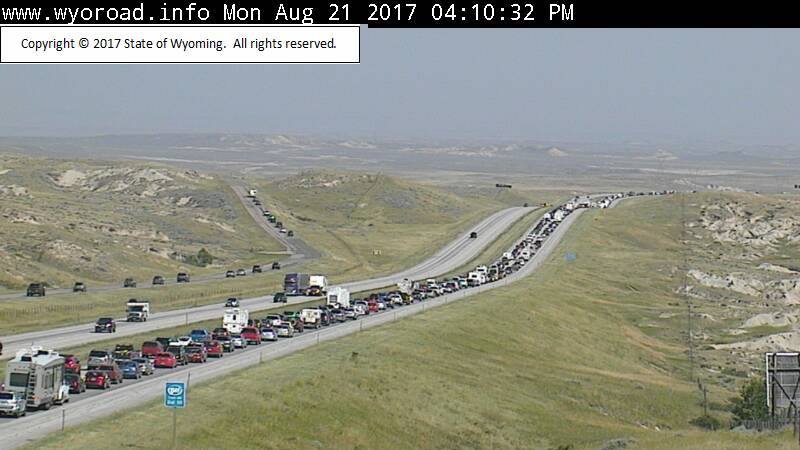
We later found out that the Glendo area had been inundated with over 100,000 visitors, and there were 400,000 cars on the I-25 that day, a queue stretching from Fort Worth to Jackson. We suspect that by waiting till 3pm, we got caught up by the people leaving Jackson and Casper right after totality, but in all probability it would have made no difference what time we’d left.
Reporting Back to Base
After a few hours sleep we were up again so Mary could do a radio interview with Radio Oxford via Skype. It was a pretty surreal experience, the kids and Mark creeping around the room trying to be quiet while Mary was interviewed for live radio 4,600 miles away and seven hours in the future!
The rest of the holiday was less eventful, but lovely. We rested the next day making full use of the hotel spa and pool, then visited Denver Science Museum, Zoo and downtown areas, as well as driving up into the Rockies and visiting Breckenridge. We flew back a week later very tired but extremely happy. This time Catriona did not get picked up by TSA or UK Border Control….
And yes, we’re already planning our next eclipse trip !!

